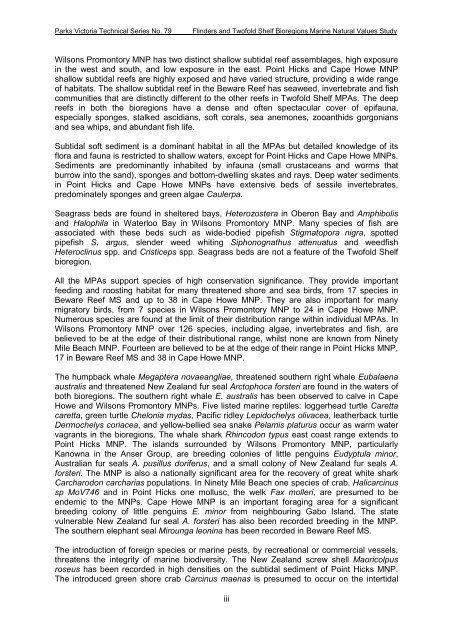parks victoria technical series marine natural values study vol 2 ...
parks victoria technical series marine natural values study vol 2 ...
parks victoria technical series marine natural values study vol 2 ...
Create successful ePaper yourself
Turn your PDF publications into a flip-book with our unique Google optimized e-Paper software.
Parks Victoria Technical Series No. 79<br />
Flinders and Twofold Shelf Bioregions Marine Natural Values Study<br />
Wilsons Promontory MNP has two distinct shallow subtidal reef assemblages, high exposure<br />
in the west and south, and low exposure in the east. Point Hicks and Cape Howe MNP<br />
shallow subtidal reefs are highly exposed and have varied structure, providing a wide range<br />
of habitats. The shallow subtidal reef in the Beware Reef has seaweed, invertebrate and fish<br />
communities that are distinctly different to the other reefs in Twofold Shelf MPAs. The deep<br />
reefs in both the bioregions have a dense and often spectacular cover of epifauna,<br />
especially sponges, stalked ascidians, soft corals, sea anemones, zooanthids gorgonians<br />
and sea whips, and abundant fish life.<br />
Subtidal soft sediment is a dominant habitat in all the MPAs but detailed knowledge of its<br />
flora and fauna is restricted to shallow waters, except for Point Hicks and Cape Howe MNPs.<br />
Sediments are predominantly inhabited by infauna (small crustaceans and worms that<br />
burrow into the sand), sponges and bottom-dwelling skates and rays. Deep water sediments<br />
in Point Hicks and Cape Howe MNPs have extensive beds of sessile invertebrates,<br />
predominately sponges and green algae Caulerpa.<br />
Seagrass beds are found in sheltered bays, Heterozostera in Oberon Bay and Amphibolis<br />
and Halophila in Waterloo Bay in Wilsons Promontory MNP. Many species of fish are<br />
associated with these beds such as wide-bodied pipefish Stigmatopora nigra, spotted<br />
pipefish S. argus, slender weed whiting Siphonognathus attenuatus and weedfish<br />
Heteroclinus spp. and Cristiceps spp. Seagrass beds are not a feature of the Twofold Shelf<br />
bioregion.<br />
All the MPAs support species of high conservation significance. They provide important<br />
feeding and roosting habitat for many threatened shore and sea birds, from 17 species in<br />
Beware Reef MS and up to 38 in Cape Howe MNP. They are also important for many<br />
migratory birds, from 7 species in Wilsons Promontory MNP to 24 in Cape Howe MNP.<br />
Numerous species are found at the limit of their distribution range within individual MPAs. In<br />
Wilsons Promontory MNP over 126 species, including algae, invertebrates and fish, are<br />
believed to be at the edge of their distributional range, whilst none are known from Ninety<br />
Mile Beach MNP. Fourteen are believed to be at the edge of their range in Point Hicks MNP,<br />
17 in Beware Reef MS and 38 in Cape Howe MNP.<br />
The humpback whale Megaptera novaeangliae, threatened southern right whale Eubalaena<br />
australis and threatened New Zealand fur seal Arctophoca forsteri are found in the waters of<br />
both bioregions. The southern right whale E. australis has been observed to calve in Cape<br />
Howe and Wilsons Promontory MNPs. Five listed <strong>marine</strong> reptiles: loggerhead turtle Caretta<br />
caretta, green turtle Chelonia mydas, Pacific ridley Lepidochelys olivacea, leatherback turtle<br />
Dermochelys coriacea, and yellow-bellied sea snake Pelamis platurus occur as warm water<br />
vagrants in the bioregions. The whale shark Rhincodon typus east coast range extends to<br />
Point Hicks MNP. The islands surrounded by Wilsons Promontory MNP, particularly<br />
Kanowna in the Anser Group, are breeding colonies of little penguins Eudyptula minor,<br />
Australian fur seals A. pusillus doriferus, and a small colony of New Zealand fur seals A.<br />
forsteri. The MNP is also a nationally significant area for the recovery of great white shark<br />
Carcharodon carcharias populations. In Ninety Mile Beach one species of crab, Halicarcinus<br />
sp MoV746 and in Point Hicks one mollusc, the welk Fax molleri, are presumed to be<br />
endemic to the MNPs. Cape Howe MNP is an important foraging area for a significant<br />
breeding colony of little penguins E. minor from neighbouring Gabo Island. The state<br />
vulnerable New Zealand fur seal A. forsteri has also been recorded breeding in the MNP.<br />
The southern elephant seal Mirounga leonina has been recorded in Beware Reef MS.<br />
The introduction of foreign species or <strong>marine</strong> pests, by recreational or commercial vessels,<br />
threatens the integrity of <strong>marine</strong> biodiversity. The New Zealand screw shell Maoricolpus<br />
roseus has been recorded in high densities on the subtidal sediment of Point Hicks MNP.<br />
The introduced green shore crab Carcinus maenas is presumed to occur on the intertidal<br />
iii

















